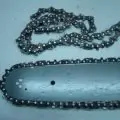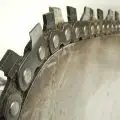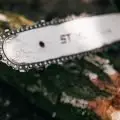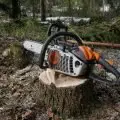Without any doubt, chainsaws are very handy tools that require a great deal of care and maintenance. Any little error like chainsaw blade direction could cause a serious accident both to the user and the surrounding. If the chainsaw blade is moving in the wrong direction, not only will it not cut the material as intended, but it may accidentally cut something else in the process.
Therefore, people query, which way does the chain go on a chainsaw? In short, when your Chainsaw bar is on the left of the engine, the chain should rotate counter-clockwise, and the cutting edges should be facing away from the engine.
This, of course, doesn’t happen typically, and it can only occur when your chainsaw blade becomes blunt and you decide to replace the blade, the bar, or the chain of your chainsaw. During this process, you may end up installing the chainsaw chain in the wrong direction by mistake.
And, this little mistake can develop into significant damage. This is likely to result in your chainsaw getting stuck in the middle of a project, and potentially causing damage to the chainsaw.
So, why take the risk? Today, we’ll provide you with all the relevant information on chainsaw blade direction, how to install chainsaw chain correctly, and the consequences of putting a chainsaw chain on backwards.
Table of Contents
- Which Way Does a Chain Go on a Chainsaw?
- Understanding the Direction of Your Chainsaw Chain
- How to Make Sure That Your Chainsaw Chain Direction Is Right
- How to Install Chainsaw Chain in the Right Direction
- The Importance of Chainsaw Chain Direction
- How Do You Know if Your Chainsaw Chain is on Backward
- FAQs (Frequently Asked Questions)
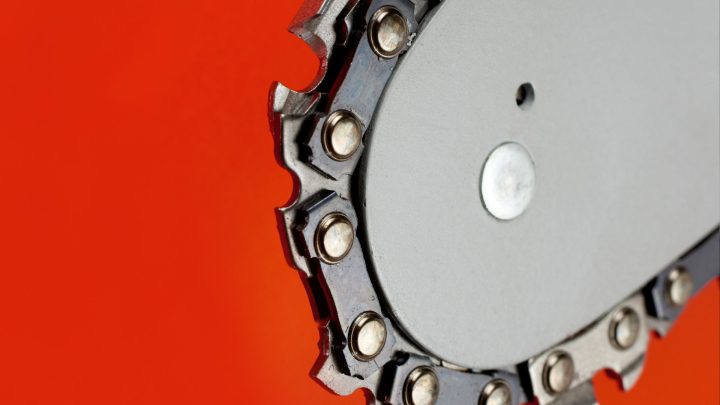
Which Way Does a Chain Go on a Chainsaw?
Here’s how to properly install a chain on a chainsaw:
- The cutting teeth on the top of the bar should be pointing towards the nose (front) of the guide bar.
- The drive links (the small, round parts of the chain that fit into the guide bar’s groove) should be engaged with the sprocket at the base of the guide bar.
- As you look down at the top of the guide bar, the cutting teeth should be pointing clockwise around the bar.
- If the chain is installed backward, the chainsaw will not cut properly and may cause damage to the saw or increase the risk of injury to the operator.
- Always refer to your chainsaw’s user manual for specific instructions, as some models may have unique features or requirements for chain installation.
Remember to wear protective gloves when handling the chain to avoid injuries from the sharp cutting teeth. Also, ensure that the chain is properly tensioned after installation and before using the chainsaw. A loose chain can derail from the guide bar, while an overly tight chain can cause damage to the saw and increase the risk of breakage.
Understanding the Direction of Your Chainsaw Chain
It is crucial for your chainsaw chain to run in the correct direction. Otherwise, it will be ineffective and potentially dangerous to you. When you are able to completely avoid this by putting chain on chainsaw in the right direction, there’s no reason not to.
Typically, a chainsaw will not cut right with a chain installed backward. In fact, if you think about it from a safety perspective, if the chainsaw chain is set backward, then it technically means that all the cutters are facing towards you rather than away from you, which can be quite dangerous.
Therefore, to understand the direction of your chainsaw chain, you will need to follow the steps on how to make sure that your chainsaw chain direction is right.
How to Make Sure That Your Chainsaw Chain Direction Is Right
If the chainsaw chain is already installed, and you’re simply checking if the chainsaw chain is in the right direction, how do you know?
For someone that is relatively new to the chainsaw operation, it may seem a little bit overwhelming and confusing, especially if it’s your first time changing a chainsaw chain. But not to worry, by the end of this article you will have a clear understanding.
So, which way does a chain go on a chainsaw? Here are tips on how to know if your chainsaw direction is right:
- Check the view from the top
- Check the view from the side and front
- Check the view from the bottom
Check the View From the Top
If you first observe your chainsaw chain from above, you will see that the top of the chain has different blades. These blades will have two edges, one sharp, and the other dull. The important part to remember is that a chainsaw blade always rotates in a clockwise direction.
The direction of the chainsaw blade (clockwise) is always the same regardless of the type or model of the chainsaw. Therefore, the sharp edges of the blade should always face the clockwise direction that the blade will rotate.
If you check from the top view, you should notice that the sharp edges are facing the opposite direction of the chainsaw body or motor.
Check the view From the Side and Front
If you are checking the chainsaw blade from its side view, you will be able to see the chainsaw blade on your right-hand side and the chainsaw engine on your left-hand side. The blade’s direction should therefore be going from left to right, in its clockwise direction. If not, your chainsaw blade direction is wrong.
You can also check your chainsaw from the front view. If the blade is in the correct direction, you will be able to see it coming from the upside to the downside. However, if it is the opposite, then you will know that it has be installed wrong.
Check the View From the Bottom
When checking the view from the bottom, as you can guess, it will be the opposite of the view from the top. If the blade is placed in the correct direction, then you will be able to see that the blade is facing towards the engine or the body.
How to Install Chainsaw Chain in the Right Direction
If you’re about to install your chainsaw chain, or after installing your chainsaw chain you still face problems while cutting with your chainsaw due to it being in the wrong direction, then don’t worry. The following tips will teach you how to install chainsaw chain in the right direction.
All you just need to do is to carefully follow this simple chain replacement procedure, and you will be good to go without any worries. Before you know it, your chainsaw will be working properly again and you can continue with your projects.
How to put a chainsaw blade on can be done in 3 simple steps:
- Attach the chainsaw bar & chain
- Check the direction of the chainsaw chain
- Tighten the blade
Let’s take a look at each of these in more detail!
1. Attach the Chainsaw Bar & Chain
The first step, presuming that you’ve already taking apart the chainsaw, is to replace a chainsaw chain is to attach the chainsaw bar to the chain. You will need to remove the bolt in order to do this, and after removing the bolt, you can attach the bar carefully to the exact position.
When you have the bar attached, make sure you adjust it properly tightening the bolt ever so slightly. The bar you’re installing should have the perfect length according to chain fitting requirements.
It’s very important that when you want to adjust the bar, you do it in such a way that you can easily place the chain on it for a perfect fit. Now you can place the chain on the bar and hopefully the fitting of your chainsaw chain should not be too tight. If it is, try to loosen the chain fitting slightly, and you will then hopefully have the perfect result.
2. Check the Direction of the Chainsaw Chain
Now, this is definitely the most crucial part. When placing the chain on the chainsaw bar, please pay close attention to the details, and make sure you are mounting the chain in the correct direction.
If you have successfully done this, your chainsaw work as it should without any disruption. Refer to the previous steps on how to check the right direction of the chain in order to make sure you get this right.
3. Tighten the Blade
Finally, now that you have mounted in the correct direction of the blade, it is time for the final procedure. The next step is to tighten the chain so that you can run your chainsaw freely without any form of obstruction.
However, you should take great care when tightening up the chainsaw chain size. It is important that you don’t make it either too loose or too tight, it must be perfect. Too loose of a chain will cause the chain to slip off, and this can also be very dangerous for whomever is using it. Tightening the chain too tight may also hamper the working condition of the chainsaw, which will ultimately lead to ineffectiveness.
The Importance of Chainsaw Chain Direction
If you are a regular chainsaw user, then you should already be aware of the problems that come with installing the chainsaw chain in the incorrect direction. However, for those who are new to using a chainsaw, this section will be of particular help to you.
Seeming as the cutting teeth on the chainsaw blade are designed to cut in one direction, if installed in the incorrect direction, the tool will not only not cut properly but may also result in a number of problems. These consequences you may experience include:
- Waste of bar oil
- Damage to the chain link
- Unnecessary stress on the guide bar
- Deteriotation of the motor
- Clutch burnout
- Doubting your skill
1. Waste of Bar Oil
When the chain is installed in the wrong direction on the chainsaw, it will cause a lot of the bar oil to be wasted. Though, this isn’t going to cause instant damage to the chainsaw, it will be costing you money in bar oil without being able to successfully complete any projects.
2. Damage to the Chain Link
The chain link is a very important component of the chainsaw, and the saw may not be able to operate effectively the moment it gets damaged. You must always make sure that the drive link has been fixed in order to avoid any unnecessary damages to you or your project.
3. Unnecessary Stress on the Guide Bar
When it comes to cutting wood, the guide bar is the most important part of the chain saw, therefore, if the direction of the chainsaw blade is wrong, you will undoubtedly experience problems. A considerable amount of stress will be brought upon the guide bar as the chain is being forced into the wood as the cut will not be possible. This stress will lead to damage occuring on the guide bar.
4. Deterioration of the Motor
Due to having to apply additional pressure to cut the wood because you’re using dull edges with the chain in the opposite direction, this will cause the gradual deterioration of the motor, resulting in chainsaw bogging down.
5. Clutch Burnout
When you start your chainsaw up, pressing down the clutch is normal as it is responsible for facilitating the proper functioning of the chainsaw. However, if your chainsaw isn’t cutting because the chain is in the wrong direction, it will cause the clutch to burn, which can lead to your chainsaw not working at all. In a lot of cases, the clutch will be the only part of the chainsaw which burns out and potentially the chainsaw smoking when cutting.
6. Doubting Your Skills
Finally, if you’re struggling to cut wood with your chains, you’re likely to start losing confidence in your skills. To be able to place the chainsaw chain in the correct direction is one of the necessary skills which chainsaw users need to demonstrate in order to prove their abilities.
Why Does the Chainsaw Chain Direction Matter?
The direction of the chainsaw chain matters for several important reasons related to the proper functioning, efficiency, and safety of the chainsaw:
- Cutting efficiency: Chainsaw chains are designed to cut wood when the teeth are oriented in the correct direction. If the chain is installed backward, the cutting teeth will be facing the wrong way, resulting in poor cutting performance or no cutting ability at all.
- Kickback risk: When the chain is installed correctly, the depth gauges (also called rakers) in front of each cutting tooth help minimize the risk of kickback by controlling the depth of the cut. If the chain is backward, the depth gauges will be in the wrong position, increasing the likelihood of kickback and potential injury to the operator.
- Chain and bar wear: Running a chainsaw with the chain installed backward can cause excessive wear on the cutting teeth, guide bar, and drive sprocket. This can lead to premature damage and reduced life span of these components.
- Operator safety: A properly installed chain is crucial for maintaining control over the chainsaw during operation. A backward chain can cause unpredictable behavior, increasing the risk of accidents and injuries.
- Proper lubrication: Chainsaw chains are designed to pick up oil from the guide bar and distribute it along the length of the chain. If the chain is installed backward, it may not receive proper lubrication, leading to increased friction, heat buildup, and potential damage to the chain and guide bar.
To ensure optimal performance, safety, and longevity of your chainsaw, always double-check that the chain is installed in the correct direction before using the saw.
How Do You Know if Your Chainsaw Chain is on Backward
If your chainsaw chain is installed backward, it won’t cut effectively, and attempting to use the chainsaw in this condition can be frustrating and unsafe.
Here’s how to tell if the chain is on backward:
- Check the Cutting Teeth Direction: The cutting teeth should be facing forward towards the tip of the chainsaw bar on the top side of the bar. If the sharp edges of the teeth point towards the chainsaw on the top of the bar, the chain is on backward.
- Look for Arrows: Some chains have directional arrows printed on them. These arrows should point towards the front of the chainsaw on the top side of the bar. If the arrows point towards the back of the chainsaw, the chain is installed incorrectly.
- Inspect the Cutting Performance: A backward chain will struggle to cut or may not cut at all, merely grinding against the wood without making significant progress. If you notice your chainsaw isn’t cutting as expected, turn it off and inspect the chain orientation.
- Observe the Drive Links: The bottom part of the chain that fits into the bar’s groove, known as the drive links, can sometimes provide a clue. The orientation of these should match the chainsaw’s drive sprocket’s motion. If it looks like the chain wouldn’t catch properly on the sprocket, it might be backward.
- Safety Features Alignment: The depth gauges or rakers are in front of the cutting teeth and should lead the teeth into the cut. If the chain is on backward, these elements will trail the teeth, not effectively control the depth of the cut.
FAQs (Frequently Asked Questions)
What direction does a chainsaw blade go?
The correct direction for a blade to face is with the sharp edges of the blade teeth facing toward the way the blade rotates. The direction of the chainsaw blade (clockwise) is always the same regardless of the type or model of the chainsaw. Therefore, these sharp edges of the blade teeth should always face the clockwise direction that the blade will rotate. You want the pointy edges of the blades rotating on top of the chain bar, moving toward the tip of the bar, and away from the body of the machine.
Is it possible to put a chainsaw blade on backwards?
Yes, this is possible which is exactly what the problem is. A chainsaw will not cut right with a chain installed backward. In fact, if you think about it from a safety perspective, if the chainsaw chain is set backward, then it technically means that all the cutters are facing towards you rather than away from you, which can be quite dangerous. Not only this, but placing the chainsaw blade in the wrong direction can result in a waste of bar oil, damage to the chain link, unnecessary stress on the guide bar, deterioration of the motor, and even clutch burnout.
Can you put a chainsaw blade on upside down?
The term “chainsaw blade” often refers to the chainsaw’s guide bar, which is the long, thin bar that the chain wraps around. It’s more common to install a chainsaw chain incorrectly than the guide bar itself, but it is possible to install the guide bar in a way that’s not optimal or recommended, depending on how you define “upside down.”

